Buick Encore: Repair instructions
Front disc brake pads replacement
Removal Procedure
WARNING: Refer to Brake Dust Warning .
WARNING: Refer to Brake Fluid Irritant Warning .
NOTE: Always replace disc brake pads in axle sets.
- Inspect the fluid level in the brake master cylinder reservoir.
- If the brake fluid level is midway between the maximum-full point and the minimum allowable level, no brake fluid needs to be removed before proceeding.
- If the brake fluid level is higher than midway between the maximum-full point and the minimum allowable level, remove brake fluid to the midway point before proceeding.
- Raise and support the vehicle. Refer to Lifting and Jacking the Vehicle .
- Remove the tire and wheel assembly. Refer to Tire and Wheel Removal and Installation .
- Place a large C-clamp over the brake caliper body and against the outer brake pad.
- Using the C-clamp, compress the brake caliper piston fully into the brake caliper bore.
.gif)
Fig. 12: Lower Brake Caliper Guide Pin Bolt
NOTE:
- DO NOT use any air tools to remove or install the guide pin bolts. Use hand tools ONLY.
- Install an open end wrench to hold the caliper guide pin in line with the brake caliper while removing or installing the caliper guide pin bolt. DO NOT allow the open end wrench to come in contact with the brake caliper. Allowing the open end wrench to come in contact with the brake caliper will cause a pulsation when the brakes are applied.
- Using a backup wrench to hold the brake caliper guide pin stationary, remove the lower brake caliper guide pin bolt (1).
CAUTION: Support the brake caliper with heavy mechanic wire, or equivalent, whenever it is separated from its mount and the hydraulic flexible brake hose is still connected. Failure to support the caliper in this manner will cause the flexible brake hose to bear the weight of the caliper, which may cause damage to the brake hose and in turn may cause a brake fluid leak.
- Rotate the brake caliper upward and support with heavy mechanics wire.
.gif)
Fig. 13: Inner And Outer Brake Pads
NOTE: Note the location of the brake pad wear sensor for correct installation.
- Remove the inner brake pad (1).
- Remove the outer brake pad (2).
.gif)
Fig. 14: Brake Pad Springs
- Remove the upper and lower brake pad springs (1).
- If installing new brake pads, discard the brake pad springs.
Installation Procedure
- Thoroughly clean the contact surfaces of the brake caliper bracket of any corrosion or debris.
.gif)
Fig. 15: Brake Pad Springs
NOTE: If installing new brake pads, install new brake pad springs.
- Install the upper and lower brake pad springs (1).
.gif)
Fig. 16: Inner And Outer Brake Pads
NOTE: Note the location of the brake pad wear sensor for correct installation.
- Install the inner brake pad (1).
- Install the outer brake pad (2).
- Position the brake caliper over the brake pads and to the caliper bracket.
.gif)
Fig. 17: Lower Brake Caliper Guide Pin Bolt
CAUTION: Refer to Fastener Caution .
- Using a backup wrench to hold the brake caliper guide pin stationary, install the lower brake caliper guide pin bolt (1) and tighten to 28 (21 lb ft).
- Install the tire and wheel assembly. Refer to Tire and Wheel Removal and Installation .
- With the engine OFF, gradually apply the brake pedal to approximately 2/3 of its travel distance.
- Slowly release the brake pedal.
- Wait 15 seconds, then repeat steps 8-9 until a firm brake pedal is obtained. This will properly seat the brake caliper piston and brake pads.
- Fill the master cylinder reservoir. Refer to Master Cylinder Reservoir Filling .
- Burnish the brake pads and rotors. Refer to Brake Pad and Rotor Burnishing.
Rear disc brake pads replacement
Removal Procedure
WARNING: Refer to Brake Dust Warning .
- Inspect the fluid level in the brake master cylinder reservoir.
- If the brake fluid level is midway between the maximum-full point and the minimum allowable level, no brake fluid needs to be removed before proceeding.
- If the brake fluid level is higher than midway between the maximum-full point and the minimum allowable level, remove brake fluid to the midway point before proceeding.
- Raise and support the vehicle. Refer to Lifting and Jacking the Vehicle .
- Remove the tire and wheel assembly. Refer to Tire and Wheel Removal and Installation .
.gif)
Fig. 18: Caliper Guide Pin Bolts
NOTE:
- DO NOT use any air tools to remove or install the guide pin bolts. Use hand tools ONLY.
- Install an open end wrench to hold the caliper guide pin in line with the brake caliper while removing or installing the caliper guide pin bolt. DO NOT allow the open end wrench to come in contact with the brake caliper. Allowing the open end wrench to come in contact with the brake caliper will cause a pulsation when the brakes are applied.
- Using a backup wrench to hold the brake caliper guide pin stationary, remove the upper brake caliper guide pin bolt (1).
CAUTION: Support the brake caliper with heavy mechanic wire, or equivalent, whenever it is separated from its mount and the hydraulic flexible brake hose is still connected. Failure to support the caliper in this manner will cause the flexible brake hose to bear the weight of the caliper, which may cause damage to the brake hose and in turn may cause a brake fluid leak.
- Rotate the brake caliper downward and support with heavy mechanics wire.
.gif)
Fig. 19: Disc Brake Pads
- Remove the outer brake pad (1).
NOTE: The inner brake pad is equipped with the wear sensor.
- Remove the inner brake pad (2).
.gif)
Fig. 20: Lower Brake Pad Springs
- Remove the upper and lower brake pad springs (1).
Installation Procedure
- Thoroughly clean the contact surfaces of the brake caliper bracket of any corrosion or debris.
.gif)
Fig. 21: Lower Brake Pad Springs
NOTE: If installing new brake pads, install new brake pad springs.
- Install the upper and lower brake pad springs (1).
.gif)
Fig. 22: Disc Brake Pads
- Install the outer brake pad (1).
NOTE: The inner brake pad is equipped with the wear sensor.
- Install the inner brake pad (2).
- Using an appropriate brake caliper piston spanner tool, slowly rotate the brake caliper piston clockwise while applying inward pressure to the brake caliper piston until the piston is fully seated in the brake caliper housing.
- Ensure the notches in the brake caliper piston align correctly with the pins on the inner disc brake pad.
- Position the brake caliper over the brake pads and to the caliper bracket.
.gif)
Fig. 23: Caliper Guide Pin Bolts
CAUTION: Refer to Fastener Caution .
- Using a backup wrench to hold the brake caliper guide pin stationary, install the upper brake caliper guide pin bolt (1) and tighten to 28 N.m (21 lb ft).
- Install the tire and wheel assembly. Refer to Tire and Wheel Removal and Installation .
- With the engine OFF, gradually apply the brake pedal to approximately 2/3 of its travel distance.
- Slowly release the brake pedal.
- Wait 15 seconds, then repeat steps 8-9 until a firm brake pedal is obtained. This will properly seat the brake caliper piston and brake pads.
- Fill the master cylinder reservoir. Refer to Master Cylinder Reservoir Filling .
- Burnish the brake pads and rotors. Refer to Brake Pad and Rotor Burnishing.
Brake pad and rotor burnishing
WARNING: Road test a vehicle under safe conditions and while obeying all traffic laws. Do not attempt any maneuvers that could jeopardize vehicle control.
Failure to adhere to these precautions could lead to serious personal injury and vehicle damage.
Burnishing the brake pads and brake rotors is necessary in order to ensure that the braking surface are properly prepared after service has been performed on the disc brake system.
This procedure should be performed whenever the disc brake rotors have been refinished or replaced, and/or whenever the brake pads have been replaced.
- Select a smooth road with little or no traffic.
- Accelerate the vehicle to 48 km/h (30 mph).
NOTE: Use care to avoid overheating the brakes while performing this step as it may adversely affect the heating characteristics of the NEW brake pad material.
- Using moderate pressure, apply the brakes to bring the vehicle to a stop. Do not allow the brakes to lock.
- Repeat steps 2 and 3 until approximately 20 stops have been completed. Allow sufficient cooling periods between stops in order to properly burnish the brake pads and rotors.
FRONT BRAKE CALIPER REPLACEMENT
Removal Procedure
WARNING: Refer to Brake Dust Warning .
WARNING: Refer to Brake Fluid Irritant Warning .
- Raise and support the vehicle. Refer to Lifting and Jacking the Vehicle .
- Remove the tire and wheel assembly. Refer to Tire and Wheel Removal and Installation .
.gif)
Fig. 24: Brake Hose Fitting And Bolt
- Remove the brake hose fitting bolt (1).
NOTE: Do not reuse the brake hose fitting gaskets.
- Remove and discard the brake hose fitting gaskets (2) from the brake hose fitting (3).
- Cap the brake hose fitting to prevent brake fluid loss and contamination.
.gif)
Fig. 25: Brake Caliper Guide Pin Bolts
NOTE:
- DO NOT use any air tools to remove or install the guide pin bolts. Use hand tools ONLY.
- Install an open end wrench to hold the caliper guide pin in line with the brake caliper while removing or installing the caliper guide pin bolt. DO NOT allow the open end wrench to come in contact with the brake caliper. Allowing the open end wrench to come in contact with the brake caliper will cause a pulsation when the brakes are applied.
- Using a backup wrench to hold the brake caliper guide pin stationary, remove the brake caliper guide pin bolts (1).
- Remove the brake caliper.
Installation Procedure
.gif)
Fig. 26: Brake Caliper Guide Pin Bolts
- Position the brake caliper over the brake pads and to the caliper bracket.
CAUTION: Refer to Fastener Caution .
- Using a backup wrench to hold the brake caliper guide pin stationary, install the brake caliper guide pin bolts (1) and tighten to 28 N.m (21 lb ft).
.gif)
Fig. 27: Brake Hose Fitting And Bolt
NOTE: Install new brake hose fitting gaskets.
- Assemble the brake hose fitting bolt (1) and the 2 new brake hose fitting gaskets (2) to the brake hose fitting (3).
- Install the brake hose assembly and tighten the brake hose fitting bolt to 40 N.m (30 lb ft).
- Bleed the hydraulic brake system. Refer to Hydraulic Brake System Bleeding (Manual) , Hydraulic Brake System Bleeding (Pressure) .
- Install the tire and wheel assembly. Refer to Tire and Wheel Removal and Installation .
Rear brake caliper replacement
Removal Procedure
WARNING: Refer to Brake Dust Warning .
WARNING: Refer to Brake Fluid Irritant Warning .
- Raise and support the vehicle. Refer to Lifting and Jacking the Vehicle .
- Remove the tire and wheel assembly. Refer to Tire and Wheel Removal and Installation
.gif)
Fig. 28: Left Parking Brake Cable
- Disconnect the parking brake cable (1) from the parking brake actuator lever.
.gif)
Fig. 29: Brake Hose Fitting Bolt
- Remove the brake hose fitting bolt (1).
NOTE: Do not reuse the brake hose fitting gaskets.
- Remove and discard the brake hose fitting gaskets (2) from the brake hose fitting (3).
- Cap the brake hose fitting to prevent brake fluid loss and contamination.
.gif)
Fig. 30: Caliper Guide Pins
NOTE:
- DO NOT use any air tools to remove or install the guide pin bolts. Use hand tools ONLY.
- Install an open end wrench to hold the caliper guide pin in line with the brake caliper while removing or installing the caliper guide pin bolt. DO NOT allow the open end wrench to come in contact with the brake caliper. Allowing the open end wrench to come in contact with the brake caliper will cause a pulsation when the brakes are applied.
- Using a backup wrench to hold the brake caliper guide pin stationary, remove the brake caliper guide pin bolts (1).
- Remove the brake caliper.
Installation Procedure
.gif)
Fig. 31: Caliper Guide Pins
- Position the brake caliper over the brake pads and to the caliper bracket.
CAUTION: Refer to Fastener Caution
- Using a backup wrench to hold the brake caliper guide pin stationary, install the brake caliper guide pin bolts (1) and tighten to 28 N.m (21 lb ft).
.gif)
Fig. 32: Brake Hose Fitting Bolt
NOTE: Install new brake hose fitting gaskets.
- Assemble the brake hose fitting bolt (1) and the new brake hose fitting gaskets (2) to the brake hose fitting (3).
- Install the brake hose assembly and tighten the brake hose fitting bolt to 40 N.m (30 lb ft).
.gif)
Fig. 33: Left Parking Brake Cable
- Install the parking brake cable (1) to the parking brake actuator lever.
- Bleed the hydraulic brake system. Refer to Hydraulic Brake System Bleeding (Manual) , Hydraulic Brake System Bleeding (Pressure) .
- Install the tire and wheel assembly. Refer to Tire and Wheel Removal and Installation .
Front brake caliper overhaul
Disassembly Procedure
WARNING: Refer to Brake Dust Warning .
WARNING: Refer to Brake Fluid Irritant Warning .
WARNING: Use of eye goggles is necessary to prevent personal injury.
CAUTION: Refer to Brake Fluid Effects on Paint and Electrical Components Caution
- Remove the brake caliper from the vehicle. Refer to Front Brake Caliper Replacement.
.gif)
Fig. 34: Using Low Pressure Compressed Air To Remove Brake Caliper Piston
WARNING: Do not place fingers in front of the caliper piston(s) in an attempt to catch or protect it when applying compressed air. The piston(s) can fly out with force and could result in serious bodily injury.
CAUTION: Use clean cloths to pad interior of caliper housing during piston removal. Use just enough air to ease the pistons out of the bores. If the pistons are blown out, even with the padding provided, it may be damaged.
.gif)
Fig. 35: Exploded View Of Brake Caliper
- Remove the brake caliper piston from the caliper bore by directing low pressure compressed air into the caliper (1) through the fluid inlet hole.
- Remove the piston dust boot seal (1) from the seal counterbore in the caliper (4). Discard the boot seal.
- Using a small wooden or plastic tool, remove the piston seal (3) from the caliper bore. Discard the piston seal.
- Remove the bleeder valve cap (6).
- Remove the bleeder valve (5).
NOTE: Do not use abrasives to clean the brake caliper piston.
- If cracks, scoring, pitting, excessive rust, and/or excessive corrosion are present in the caliper bore, replace the caliper assembly.
- If light rust or light corrosion are present in the caliper bore, attempt to remove the imperfection with a fine emery paper. If the imperfection cannot be removed, replace the caliper assembly.
- Clean the brake caliper piston bore and seal counterbore, and the caliper piston with denatured alcohol, or equivalent.
- Dry the caliper piston bore and counterbore, and the piston with non-lubricated, filtered, compressed air.
- Inspect the caliper piston for cracks, scoring, and/or damage to the plating. Replace the caliper piston if any of these conditions exist.
- Inspect the caliper mounting holes for cracks, scoring, pitting, rust and/or excessive corrosion. Replace the caliper assembly if any of these conditions exist.
Assembly Procedure
.gif)
Fig. 36: Exploded View Of Brake Caliper
- Lubricate the new piston seal (3) with brake fluid from a clean, sealed brake fluid container.
- Install the lubricated, new piston seal into the caliper bore.
- Apply a thin coat of brake fluid from a clean, sealed brake fluid container.
.gif)
Fig. 37: View Of Caliper Piston And Caliper Piston Dust Boot Seal
- Install the new piston dust boot seal (1) over the caliper piston (2).
- Install the bottom half of the caliper piston into the caliper bore.
- Compress the caliper piston to the bottom of the caliper bore.
- Fully seat the piston dust boot seal into caliper counterbore.
CAUTION: Refer to Fastener Caution .
- Install the bleeder valve to the caliper and tighten to 17 (13 lb ft).
- Install the bleeder valve cap.
- Install the brake caliper to the vehicle. Refer to Front Brake Caliper Replacement.
Front brake caliper bracket replacement
Removal Procedure
WARNING: Refer to Brake Dust Warning .
- Raise and support the vehicle. Refer to Lifting and Jacking the Vehicle .
- Remove the tire and wheel assembly. Refer to Tire and Wheel Removal and Installation .
.gif)
Fig. 38: Upper And Lower Brake Caliper Guide Pin Bolts
NOTE:
- DO NOT use any air tools to remove or install the guide pin bolts. Use hand tools ONLY.
- Install an open end wrench to hold the caliper guide pin in line with the brake caliper while removing or installing the caliper guide pin bolt. DO NOT allow the open end wrench to come in contact with the brake caliper. Allowing the open end wrench to come in contact with the brake caliper will cause a pulsation when the brakes are applied.
- Hold the brake caliper guide pin stationary and remove the brake caliper guide pin bolts (1).
CAUTION: Support the brake caliper with heavy mechanic wire, or equivalent, whenever it is separated from its mount and the hydraulic flexible brake hose is still connected. Failure to support the caliper in this manner will cause the flexible brake hose to bear the weight of the caliper, which may cause damage to the brake hose and in turn may cause a brake fluid leak.
- Remove the brake caliper and support with heavy mechanics wire.
.gif)
Fig. 39: Brake Pads
NOTE: Note the location of the wear sensor for correct installation.
- Remove the inner brake pad (1).
- Remove the outer brake pad (2).
.gif)
Fig. 40: Brake Pad Shims
- Remove the brake pad springs (1).
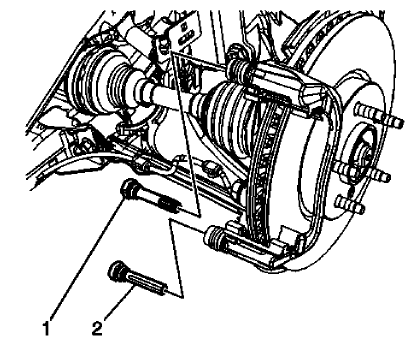
Fig. 41: Upper And Lower Brake Caliper Guide Pins
NOTE: The upper brake caliper guide pin is equipped with a bushing and must be installed in the same location.
- Remove the upper brake caliper guide pin (1).
- Remove the lower brake caliper guide pin (2).
- Remove the 2 brake caliper guide pin seals.
.gif)
Fig. 42: Brake Caliper Bracket Bolts
NOTE: Do not reuse the brake caliper bracket bolts.
- Remove and discard the brake caliper bracket bolts (1).

Fig. 43: Brake Caliper Bracket
- Remove the brake caliper bracket (1).
Installation Procedure

Fig. 44: Brake Caliper Bracket
- Install the brake caliper bracket (1).
.gif)
Fig. 45: Brake Caliper Bracket Bolts
CAUTION: Refer to Fastener Caution
- Install new brake caliper bracket bolts (1) and tighten to 160 (118 lb ft).

Fig. 46: Brake Pad Shims
- Install the brake pad springs (1).
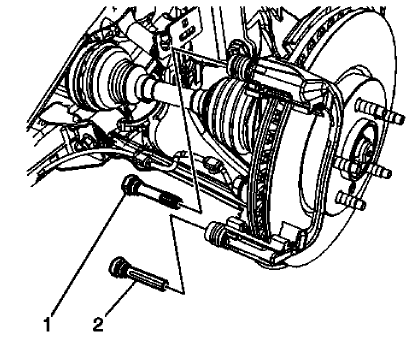
Fig. 47: Upper And Lower Brake Caliper Guide Pins
- Install the 2 brake caliper guide pin seals.
- Ensure the brake caliper guide pin seals are fully seated in the groove of the brake caliper bracket.
NOTE: The upper brake caliper guide pin is equipped with a bushing and must be installed in the same location.
- Install the upper brake caliper guide pin (1).
- Install the lower brake caliper guide pin (2).
- Ensure the brake caliper guide pin seals are fully seated in the groove of the brake caliper guide pins.
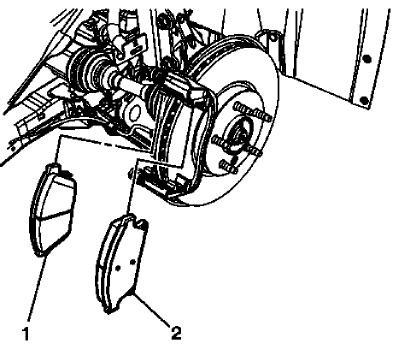
Fig. 48: Brake Pads
NOTE: Note the location of the wear sensor for correct installation.
- Install the inner brake pad (1).
- Install the outer brake pad (2).
- Position the brake caliper over the brake pads and to the caliper bracket.
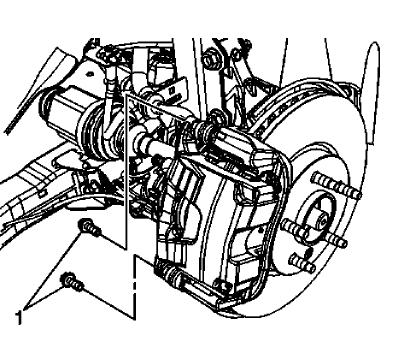
Fig. 49: Upper And Lower Brake Caliper Guide Pin Bolts
- Using a backup wrench to hold the brake caliper guide pin stationary, install the brake caliper guide pin bolts (1) and tighten to 28 (21 lb ft).
- Install the tire and wheel assembly. Refer to Tire and Wheel Removal and Installation .
Rear brake caliper bracket replacement
Removal Procedure
WARNING: Refer to Brake Dust Warning .
- Raise and support the vehicle. Refer to Lifting and Jacking the Vehicle .
- Remove the tire and wheel assembly. Refer to Tire and Wheel Removal and Installation .
- Remove the rear brake caliper. Refer to Rear Brake Caliper Replacement.

Fig. 50: Disc Brake Pads
- Remove the outer brake pad (1).
NOTE: The inner brake pad is equipped with the wear sensor.
- Remove the inner brake pad (2).
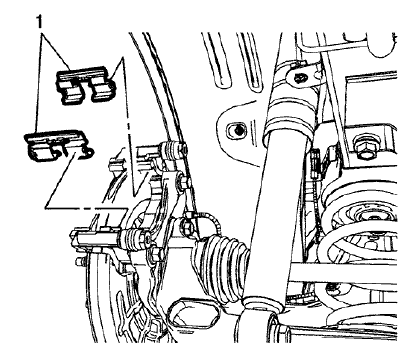
Fig. 51: Lower Brake Pad Springs
- Remove the upper and lower brake pad springs (1).

Fig. 52: Upper Brake Caliper Guide Pin
- Remove the upper brake caliper guide pin (1).
NOTE: The lower brake caliper guide pin is equipped with a bushing and must be installed in the same location.
- Remove the lower brake caliper guide pin (2).

Fig. 53: Brake Caliper Bracket Bolts
NOTE: Do not reuse the brake caliper bracket bolts.
- Remove and discard the brake caliper bracket bolts (1).
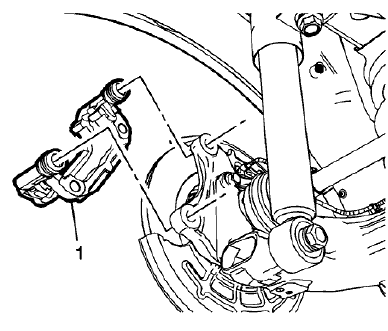
Fig. 54: Rear Brake Caliper Bracket
- Remove the rear brake caliper bracket (1).
Installation Procedure

Fig. 55: Rear Brake Caliper Bracket
- Install the rear brake caliper bracket (1).
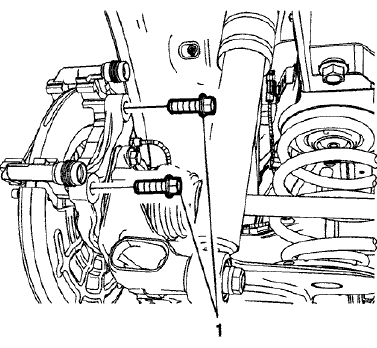
Fig. 56: Brake Caliper Bracket Bolts
CAUTION: Refer to Fastener Caution .
- Install new brake caliper bracket bolts (1) and tighten to 100 (74 lb ft).

Fig. 57: Upper Brake Caliper Guide Pin
- Install the upper brake caliper guide pin (1).
NOTE: The lower brake caliper guide pin is equipped with a bushing and must be installed in the same location.
- Install the lower brake caliper guide pin (2).

Fig. 58: Lower Brake Pad Springs
- Install the upper and lower brake pad springs (1).

Fig. 59: Disc Brake Pads
- Install the outer brake pad (1).
NOTE: The inner brake pad is equipped with the wear sensor.
- Install the inner brake pad (2).
- Install the rear brake caliper. Refer to Rear Brake Caliper Replacement.
- Install the tire and wheel assembly. Refer to Tire and Wheel Removal and Installation .
Front brake rotor replacement
Special Tools
- CH-41013 Rotor Resurfacing Kit
- CH-42450-A Wheel Hub Resurfacing Kit
For equivalent regional tools, refer to Special Tools.
Removal Procedure
WARNING: Refer to Brake Dust Warning .
- Raise and support the vehicle. Refer to Lifting and Jacking the Vehicle .
- Remove the tire and wheel assembly. Refer to Tire and Wheel Removal and Installation .
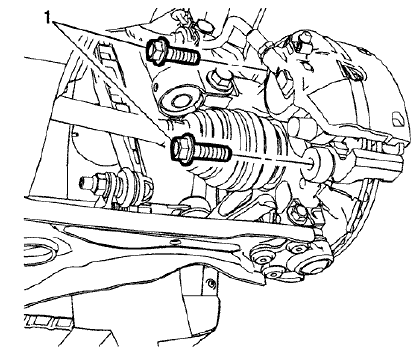
Fig. 60: Brake Caliper Bracket Bolts
NOTE: Do not reuse the brake caliper bracket bolts.
- Remove and discard the brake caliper bracket bolts (1).
CAUTION: Support the brake caliper with heavy mechanic wire, or equivalent, whenever it is separated from its mount and the hydraulic flexible brake hose is still connected. Failure to support the caliper in this manner will cause the flexible brake hose to bear the weight of the caliper, which may cause damage to the brake hose and in turn may cause a brake fluid leak.
- Remove the brake caliper and bracket as an assembly and support with heavy mechanics wire.

Fig. 61: Brake Rotor Bolt
- Remove the brake rotor bolt (1).

Fig. 62: Brake Rotor
- Remove the brake rotor (1).
Installation Procedure
- If installing a new brake rotor, clean the friction surfaces of the brake rotor with denatured alcohol.
- Using the CH-42450-A Wheel Hub Resurfacing Kit , thoroughly clean any rust or corrosion from the mating surface of the hub/axle flange.
- Using the CH-41013 Rotor Resurfacing Kit , thoroughly clean any rust or corrosion from the mating surface of the rotor to the hub/axle flange.

Fig. 63: Brake Rotor
- Install the brake rotor (1).

Fig. 64: Brake Rotor Bolt
CAUTION: Refer to Fastener Caution .
- Install the brake rotor bolt (1) and tighten to 9 N.m (80 lb in)
- Position the brake caliper and bracket assembly over the brake rotor and to the steering knuckle.

Fig. 65: Brake Caliper Bracket Bolts
- Install new brake caliper bracket bolts (1) and tighten to 160 (118 lb ft).
- Install the tire and wheel assembly. Refer to Tire and Wheel Removal and Installation .
- Burnish the brake pads and rotors. Refer to Brake Pad and Rotor Burnishing.
Rear brake rotor replacement
Special Tools
- CH-41013 Rotor Resurfacing Kit
- CH-42450-A Wheel Hub Resurfacing Kit
For equivalent regional tools, refer to Special Tools.
Removal Procedure
WARNING: Refer to Brake Dust Warning .
- Raise and support the vehicle. Refer to Lifting and Jacking the Vehicle .
- Remove the tire and wheel assembly. Refer to Tire and Wheel Removal and Installation .

Fig. 66: Brake Caliper Bracket Bolts
NOTE: Do not reuse the brake caliper bracket bolts.
- Remove and discard the brake caliper bracket bolts (1).
CAUTION: Support the brake caliper with heavy mechanic wire, or equivalent, whenever it is separated from its mount and the hydraulic flexible brake hose is still connected. Failure to support the caliper in this manner will cause the flexible brake hose to bear the weight of the caliper, which may cause damage to the brake hose and in turn may cause a brake fluid leak.
- Remove the brake caliper and bracket as an assembly and support with heavy mechanics wire.

Fig. 67: Brake Rotor Bolt
- Remove the brake rotor bolt (1).

Fig. 68: Brake Rotor
- Remove the brake rotor (1).
Installation Procedure
- If installing a new brake rotor, clean the friction surfaces of the brake rotor with denatured alcohol.
- Using the CH-42450-A Wheel Hub Resurfacing Kit , thoroughly clean any rust or corrosion from the mating surface of the hub/axle flange.
- Using the CH-41013 Rotor Resurfacing Kit , thoroughly clean any rust or corrosion from the mating surface of the rotor to the hub/axle flange.

Fig. 69: Brake Rotor
- Install the brake rotor (1).

Fig. 70: Brake Rotor Bolt
CAUTION: Refer to Fastener Caution .
- Install the brake rotor bolt (1) and tighten to 9 N.m (80 lb in).
- Position the brake caliper and bracket assembly over the brake rotor and to the suspension knuckle.

Fig. 71: Brake Caliper Bracket Bolts
- Install new brake caliper bracket bolts (1) and tighten to 100 N.m (74 lb ft).
- Install the tire and wheel assembly. Refer to Tire and Wheel Removal and Installation .
- Burnish the brake pads and rotors. Refer to Brake Pad and Rotor Burnishing.
Front brake shield replacement
Removal Procedure
WARNING: Refer to Brake Dust Warning .
- Raise and support the vehicle. Refer to Lifting and Jacking the Vehicle .
- Remove the front tire and wheel assembly. Refer to Tire and Wheel Removal and Installation .
- Remove the front brake rotor. Refer to Front Brake Rotor Replacement.

Fig. 72: Front Brake Shield Bolts
- Remove the front brake shield bolts (1).

Fig. 73: Front Brake Shield
- Remove the front brake shield (1).
Installation Procedure

Fig. 74: Front Brake Shield
- Install the front brake shield (1).
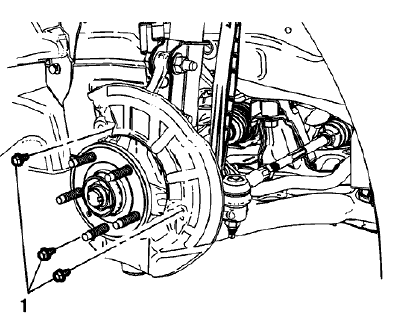
Fig. 75: Front Brake Shield Bolts
CAUTION: Refer to Fastener Caution .
- Install the front brake shield bolts (1) and tighten to 9 N.m (80 lb in).
- Install the front brake rotor. Refer to Front Brake Rotor Replacement.
- Install the tire and wheel assembly. Refer to Tire and Wheel Removal and Installation .
REAR BRAKE SHIELD REPLACEMENT
Removal Procedure
WARNING: Refer to Brake Dust Warning .
- Raise and support the vehicle. Refer to Lifting and Jacking the Vehicle .
- Remove the rear tire and wheel assembly. Refer to Tire and Wheel Removal and Installation .
- Remove the rear brake rotor. Refer to Rear Brake Rotor Replacement.

Fig. 76: Rear Brake Shield Bolts
- Remove the rear brake shield bolts (1).

Fig. 77: Rear Brake Shield
- Remove the rear brake shield (1).
Installation Procedure

Fig. 78: Rear Brake Shield
- Install the rear brake shield (1).
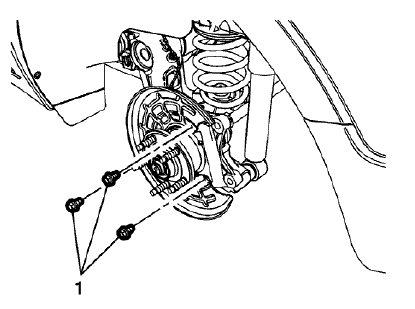
Fig. 79: Rear Brake Shield Bolts
CAUTION: Refer to Fastener Caution
- Install the rear brake shield bolts (1) and tighten to 9 N.m (80 lb in).
- Install the rear brake rotor. Refer to Rear Brake Rotor Replacement.
- Install the rear tire and wheel assembly. Refer to Tire and Wheel Removal and Installation .
Brake rotor assembled lateral runout correction
NOTE:
- Brake rotor thickness variation MUST be checked BEFORE checking for assembled lateral runout (LRO). Thickness variation exceeding the maximum acceptable level can cause brake pulsation. Refer to Brake Rotor Thickness Variation Measurement.
- Brake rotor assembled lateral runout (LRO) exceeding the maximum allowable specification can cause thickness variation to develop in the brake rotor over time, usually between 4,800-11,300 km (3,000-7,000 mi). Refer to Brake Rotor Assembled Lateral Runout Measurement.
Review the following acceptable methods for bringing the brake disc assembled LRO to within specifications.
Determine which method to use for the vehicle being repaired.
- The indexing method of correcting assembled LRO is most effective when the LRO specification is only exceeded by a relatively small amount: 0.025-0.127 mm (0.001-0.005 in). Indexing is used to achieve the best possible match of high spots to low spots between related components. Refer to Brake Rotor Assembled Lateral Runout Correction - Indexing.
- The on-vehicle brake lathe method is used to bring the LRO to within specifications through compensating for LRO while refinishing the brake rotor. Refer to Brake Rotor Assembled Lateral Runout Correction - On Vehicle Lathe.
If the assembled LRO cannot be corrected using these methods, then other components must be suspected as causing and/or contributing to the LRO concern.
BRAKE ROTOR ASSEMBLED LATERAL RUNOUT CORRECTION - INDEXING
Special Tools
CH-45101-100 Conical Brake Rotor Washers
For equivalent regional tools, refer to Special Tools.
WARNING: Refer to Brake Dust Warning .
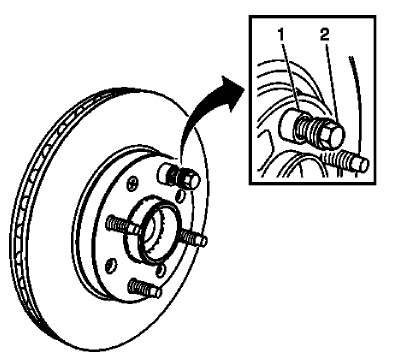
Fig. 80: One Lug Nut & Conical Brake Rotor Washers
NOTE:
- Brake rotor thickness variation MUST be checked BEFORE checking for assembled lateral runout (LRO). Thickness variation exceeding the maximum acceptable level can cause brake pulsation. Refer to Brake Rotor Thickness Variation Measurement.
- Brake rotor assembled LRO exceeding the maximum allowable
specification can cause thickness variation to develop in the brake
rotor over time, usually between 4,800-11,300 km (3,000-7,000 mi).
Refer to Brake Rotor Assembled Lateral Runout Measurement.
- Remove the CH-45101-100 conical brake rotor washers and the lug nuts that were installed during the assembled LRO measurement procedure.
- Inspect the mating surface of the hub/axle flange and the brake rotor to ensure that there are no foreign particles or debris remaining.
- Index the brake rotor in a different orientation to the hub/axle flange.
- Hold the rotor firmly in place against the hub/axle flange and install one of the CH-45101-100 conical brake rotor washers (1) and one lug nut (2) onto the upper-most wheel stud.
- Continue to hold the rotor secure and tighten the lug nut firmly by hand.
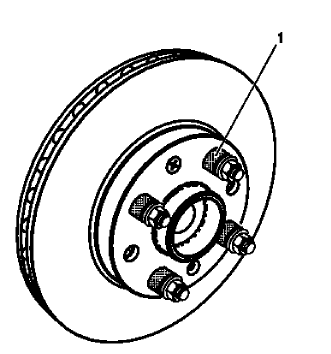
Fig. 81: Wheel Studs
- Install the remaining CH-45101-100 conical brake rotor washers and lug nuts onto the wheel studs (1) and tighten the nuts firmly by hand in the tightening sequence.
- Tighten the lug nuts in sequence, in order to properly secure the rotor. Refer to Tire and Wheel Removal and Installation .
- Measure the assembled LRO of the brake rotor. Refer to Brake Rotor Assembled Lateral Runout Measurement.
- Compare the amount of change between this measurement and the original measurement.
- If this measurement is within specifications, proceed to step 14.
- If this measurement still exceeds specifications, repeat steps 1-9 until the best assembled LRO measurement is obtained.
- Matchmark the final location of the rotor to the wheel studs if the orientation is different than it was originally.
- If the brake rotor assembled LRO measurement still exceeds the maximum allowable specification, refer to Brake Rotor Assembled Lateral Runout Correction.
- If the brake rotor assembled LRO is within specification, install the brake caliper and depress the brake pedal several times to secure the rotor in place before removing the CH-45101-100 conical brake rotor washers and the lug nuts.
Brake rotor assembled lateral runout correction - on vehicle lathe
Special Tools
CH-45101-100 Conical Brake Rotor Washers
For equivalent regional tools, refer to Special Tools.
WARNING: Refer to Brake Dust Warning .

Fig. 80: One Lug Nut & Conical Brake Rotor Washers
NOTE:
- Brake rotor thickness variation MUST be checked BEFORE checking for assembled lateral runout (LRO). Thickness variation exceeding the maximum acceptable level can cause brake pulsation. Refer to Brake Rotor Thickness Variation Measurement.
- Brake rotor assembled LRO exceeding the maximum allowable
specification can cause thickness variation to develop in the brake
rotor over time, usually between 4,800-11,300 km (3,000-7,000 mi).
Refer to Brake Rotor Assembled Lateral Runout Measurement.
- Remove the CH-45101-100 conical brake rotor washers and the lug nuts that were installed during the assembled LRO measurement procedure.
- Inspect the mating surface of the hub/axle flange and the brake rotor to ensure that there are no foreign particles or debris remaining.
- Index the brake rotor in a different orientation to the hub/axle flange.
- Hold the rotor firmly in place against the hub/axle flange and install one of the CH-45101-100 conical brake rotor washers (1) and one lug nut (2) onto the upper-most wheel stud.
- Continue to hold the rotor secure and tighten the lug nut firmly by hand.
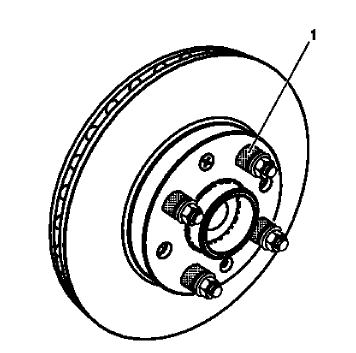
Fig. 81: Wheel Studs
- Install the remaining CH-45101-100 conical brake rotor washers and lug nuts onto the wheel studs (1) and tighten the nuts firmly by hand in the tightening sequence.
- Tighten the lug nuts in sequence, in order to properly secure the rotor. Refer to Tire and Wheel Removal and Installation .
- Measure the assembled LRO of the brake rotor. Refer to Brake Rotor Assembled Lateral Runout Measurement.
- Compare the amount of change between this measurement and the original measurement.
- If this measurement is within specifications, proceed to step 14.
- If this measurement still exceeds specifications, repeat steps 1-9 until the best assembled LRO measurement is obtained.
- Matchmark the final location of the rotor to the wheel studs if the orientation is different than it was originally.
- If the brake rotor assembled LRO measurement still exceeds the maximum allowable specification, refer to Brake Rotor Assembled Lateral Runout Correction.
- If the brake rotor assembled LRO is within specification, install the brake caliper and depress the brake pedal several times to secure the rotor in place before removing the CH-45101-100 conical brake rotor washers and the lug nuts.
Brake rotor assembled lateral runout correction - on vehicle lathe
Special Tools
CH-45101-100 Conical Brake Rotor Washers
For equivalent regional tools, refer to Special Tools.
WARNING: Refer to Brake Dust Warning .
NOTE:
- Brake rotor thickness variation MUST be checked before checking for assembled lateral runout (LRO). Thickness variation exceeding the maximum acceptable level can cause brake pulsation. Refer to Brake Rotor Thickness Variation Measurement.
- Brake rotor assembled LRO exceeding the maximum allowable
specification can cause thickness variation to develop in the brake
rotor over time, usually between 4,800-11,300 km (3,000-7,000 mi).
Refer to Brake Rotor Assembled Lateral Runout Measurement.
- Ensure that the brake caliper and brake caliper bracket that are already being supported, are clear from contacting any rotating components, such as the brake rotor.
- Remove the CH-45101-100 conical brake rotor washers and the lug nuts that were installed during the assembled LRO measurement procedure and/or the indexing correction procedure.
- Inspect the mounting surface of the hub/axle flange and the brake rotor to ensure that there are no foreign particles or debris remaining.
- Set up the lathe, following the manufacturer instructions.
- Refinish the brake rotor, following the brake lathe manufacturers instructions.
- After each successive cut, inspect the brake rotor thickness. Refer to Brake Rotor Thickness Measurement.
- If at any time the brake rotor exceeds the minimum allowable thickness after refinish specification, the brake rotor must be replaced. After replacing the brake rotor, proceed to step 10.
- After refinishing the brake rotor, use the following procedure in order to obtain the desired nondirectional finish:
- Follow the brake lathe manufacturer recommended speed setting for applying a non-directional finish.
- Using moderate pressure, apply the non-directional finish:
- If the lathe is equipped with a non-directional finishing tool, apply the finish with 120-grit aluminum oxide sandpaper.
- If the lathe is not equipped with a non-directional finishing tool, apply the finish with a sanding block and 150-grit aluminum oxide sandpaper.
- After applying a non-directional finish, clean each friction surface of the brake rotor with denatured alcohol, or an equivalent approved brake cleaner.
- Remove the lathe from the vehicle.
- Measure the assembled LRO of the brake rotor. Refer to Brake Rotor Assembled Lateral Runout Measurement.
- If the brake rotor assembled LRO measurement still exceeds the maximum allowable specification, refer to Brake Rotor Assembled Lateral Runout Correction.
- If the brake rotor assembled LRO is within specification, install the brake caliper and depress the brake pedal several times to secure the brake rotor in place before removing the CH-45101-100 conical brake rotor washers and the lug nuts.
BRAKE ROTOR REFINISHING
Special Tools
- CH-41013 Rotor Resurfacing Kit
- CH-42450-A Wheel Hub Resurfacing Kit
For equivalent regional tools, refer to Special Tools.
WARNING: Refer to Brake Dust Warning .
NOTE:
The disc brake rotors do not require refinishing as part of routine brake system service. New disc brake rotors do not require refinishing.
Do not refinish disc brake rotors in an attempt to correct the following conditions:
- Brake system noise - squeal, growl, groan
- Uneven and/or premature disc brake pad wear
- Superficial or cosmetic corrosion/rust of the disc brake rotor friction surface
- Scoring of the disc brake rotor friction surface less than the maximum allowable specification
Before refinishing a brake rotor, the rotor MUST first be checked for adequate thickness to allow the rotor to be refinished and remain above the minimum allowable thickness after refinish specification. Refer to Brake Rotor Thickness Measurement.
Disc brake rotors should only be refinished if they have adequate thickness to be refinished and if one or more of the following conditions exist:
- Thickness variation in excess of the maximum allowable specification
- Excessive corrosion/rust and/or pitting
- Cracks and/or heat spots
- Excessive blueing discoloration
- Scoring of the disc brake rotor surface in excess of the maximum allowable specification
Disc brake rotors may need to be refinished as part of the process for correcting brake rotor assembled lateral runout (LRO) that exceeds the maximum allowable specification.
NOTE: If the vehicle is equipped with cross-drilled rotors, use a lathe with positive rake tooling. This setup requires less cutting pressure, which will result in less vibration, and a better surface finish. Also, use a vibration dampener when cutting. Otherwise, refinish according to the following instructions.
NOTE: Whenever the brake rotor has been separated from the hub/axle flange, clean any rust or contaminants from the hub/axle flange and the brake rotor mating surfaces. Failure to do this may result in increased assembled lateral runout (LRO) of the brake rotor, which could lead to brake pulsation.
- Using the CH-42450-A Wheel Hub Resurfacing Kit , thoroughly clean any rust or corrosion from the mating surface of the hub/axle flange.
- Using the CH-41013 Rotor Resurfacing Kit , thoroughly clean any rust or corrosion from the mating surface and mounting surface of the brake rotor.
- Inspect the mating surfaces of the hub/axle flange and the rotor to ensure that there are no foreign particles or debris remaining.
- Mount the brake rotor to the brake lathe according to the lathe manufacturer's instructions, ensuring that all mounting attachments and adapters are clean and free of debris.
- Ensure that any vibration dampening attachments are securely in place.
- With the brake lathe running, slowly bring in the cutting tools until they just contact the brake rotor friction surfaces.
- Observe the witness mark on the brake rotor. If the witness mark extends approximately three-quarters or more of the way around the brake rotor friction surface on each side, the brake rotor is properly mounted to the lathe.
- If the witness mark does not extend three-quarters or more of the way around the brake rotor, re-mount the rotor to the lathe.
- Following the brake lathe manufacturer's instructions, refinish the brake rotor.
- After each successive cut, inspect the brake rotor thickness. Refer to Brake Rotor Thickness Measurement.
- If at any time the brake rotor exceeds the minimum allowable thickness after refinish specification, the brake rotor must be replaced.
- After refinishing the brake rotor, use the following procedure in order to obtain the desired nondirectional finish:
- Follow the brake lathe manufacturer's recommended speed setting for applying a non-directional finish.
- Using moderate pressure, apply the non-directional finish:
- If the lathe is equipped with a non-directional finishing tool, apply the finish with 120-grit aluminum oxide sandpaper.
- If the lathe is not equipped with a non-directional finishing tool, apply the finish with a sanding block and 150-grit aluminum oxide sandpaper.
NOTE: Thoroughly cleaning the brake rotor will prevent the possible transfer of finite metal dust left as a by-product of machining to the brake pad material during the burnishing process, thereby reducing the possibility for brake squeal or other brake noises to occur.
- After applying a non-directional finish, clean each friction surface of the brake rotor with a solution of mild dish washing detergent and water, or a GM approved brake cleaner and a clean shop towel to remove metal particles remaining from machining. Repeat the cleaning process if necessary to remove all metal particles.
- Remove the brake rotor from the brake lathe.
- Measure the assembled LRO of the brake rotor to ensure optimum performance of the disc brakes. Refer to Brake Rotor Assembled Lateral Runout Measurement.
- If the brake rotor assembled LRO measurement exceeds the specification, bring the LRO to within specifications. Refer to Brake Rotor Assembled Lateral Runout Correction.

